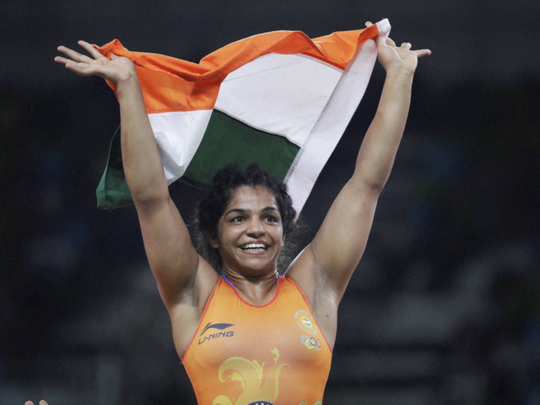
The hand-wringing over India’s humiliating run at the 2016 Rio Olympics and the ongoing punditry on why the country does so badly at these events is at its peak as the Games are about come to a close. Justin Rowlatt’s article, titled ‘Olympic Losers: Why is India so bad at sport?’ trots out the familiar excuses: Poor infrastructure, corrupt officials and a host of other reasons, including the cultural and caste traditions of India. Mercifully, the British news presenter doesn’t blame Cricket, ‘The reigning voodoo religion of India’ as some others do, for the country’s abysmal record at the Olympics. But when he talks about Shiva Keshavan, India’s greatest Winter Olympian, he gets our eyeballs rolling.
Keshavan competes in luge, a kind of super-fast sledge. In two of the past five Winter Games, he was the only Indian to qualify, the only member of a team of one. Yet, his ticket to Sochi was paid not by the Indian government but by crowdfunding. Worse still: Keshavan has had to adopt an eye-poppingly dangerous training regime due to lack of funds. So what does he do? As there are no luge facilities in India, he screwed wheels to the bottom of his sledge and practised on Himalayan roads, overtaking cars and lorries to reach speeds of up to 100km/hr. It is death-defying and not very different from a gymnast who also takes unacceptable risks for a podium-finish.
The next case is a comparison between American Simone Biles, the reigning queen of gymnastics, and Dipa Karmakar from India who narrowly lost out on a bronze medal in the women’s vault competition at Rio. Biles won gold with an average of 15.966, while Maria Paseka (15.253) of Russia and Switzerland’s Giulia Steingrubber (15.216) took home the silver and bronze medals, respectively. Karmakar averaged 15.066 and lost out by a whisker.
Artistic gymnastics, the correct nomenclature for this sport, has four performing routines — floor, uneven bars, vault and the balance beam — and if Biles had one weakness, it was on the uneven bars. She is almost flawless in all the other three routines — the ultimate all-rounder. Karmakar, on the other hand, had only one area strength — the vault. Vaults are different exercises, each with varying difficulty ratings and points are scored depending on how well these manoeuvres are executed. Essentially, the difficulty ratings depend on how many twists are executed before landing on one’s feet. The more difficult vaults are named after the gymnasts who performed them first. For example: Yurchenko, Amanar and the riskiest and most difficult of them all — the Produnova, which most gymnasts, even ‘golden’ girl Biles, shy away from because even a minor mistake can lead to serious injury and even death.
Surprisingly, India’s Karmakar made the Produnova vault all her own. Over the years, she has perfected this exercise that has the highest difficulty rating of 7.0. Karmakar uses this dangerous vault to overcome her other less-than-perfect gymnastics skills. Her critics deride her choice of this vault as a desperate gamble to get onto the podium. When gymnast Laurie Hernandez of the United States was asked about the Produnova recently, after practice, her personal coach, Maggie Haney, interjected: “We’ll never do it.” Biles put it differently: “I’m not trying to die,” she told the New Yorker magazine, referring to the Produnova.
Biles was all praise for Karmakar’s gutsy performance at Rio.
But the question to be asked is, would Karmakar have taken this risk if she had access to better coaches and training facilities? Does it not speak of a systemic failure of epic proportions in India’s sports administration? A closer look at India’s Olympic contingent shows that a large percentage of participating athletes are from rural India and this is their desperate shot at recognition and glory. Karmakar is part of that milieu. Urban India has its rifle shooters, tennis prima donnas and the newly-appointed Union Sports Minister Vijay Goel who was admonished by Sarah Peterson, the continental manager for the Rio Organising Committee, who complained, “There have been multiple reports of your Minister for Sports trying to enter accredited areas at venues with unaccredited individuals”, and talked of attempts by members of the ministerial entourage to “push past our staff” and concluded with a threat to cancel the sports minister’s accreditation and privileges at the Olympic Games if there were “further examples of this type of behaviour”.
Socialite and author Shobhaa De tweeted: “All Team India is doing at Rio is clicking selfies and not winning any medals.” She was immediately slammed on Twitter and told if stupidity was an Olympic sport then a podium finish was hers for the asking.
The Karmakar story then is essentially of an individual who, despite an Indian system that reeks of incompetence and apathy, is willing to take that death-defying step to win a medal. Harsh though this comparison is, it is similar to what is seen in urban sprawls and in street corners, where young children are forced to do death-defying stunts by their agents to eke out a living, even as the crowds gather around and throw small change at these hapless beings, once the ‘show’ is over. Not a very edifying story for a nation that is desperately wanting to erase its pathetic record at the Olympics.
But as news trickles in about India’s first medal, a bronze, at Rio, after an agonising wait for 14 days, it would seem free-style wrestler Sakshi Malek has stepped up and saved the blushes of 1.25 billion people.
Ravi Menon is a Dubai-based writer, working on a series of essays on India and on a public service initiative called India Talks.








